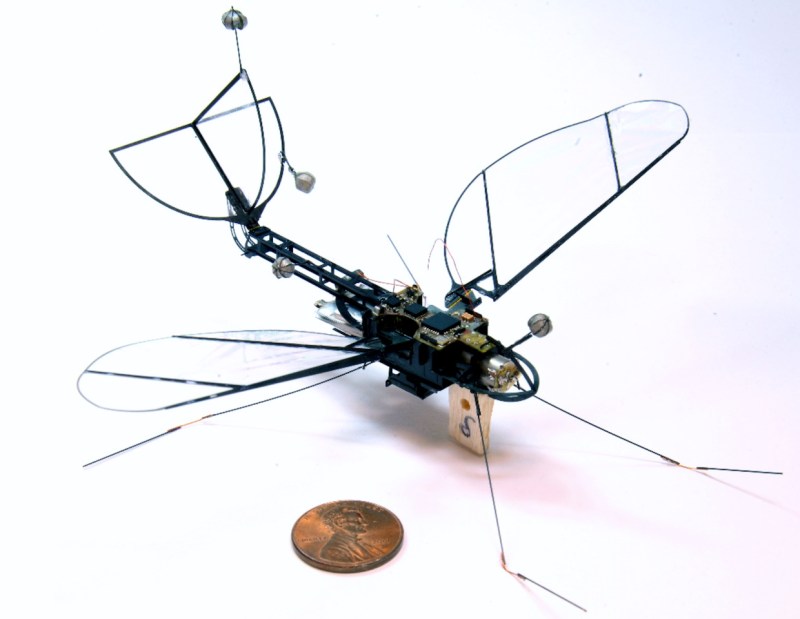Harvard University has had the flying robot insect market covered for a long time. However, their robot bee, while cool, was starting to bum them out. They wanted to put the battery and brain on the robocritter and have it fly around without a tether. Technology just wasn’t moving fast enough for them, so they’ve picked a different bug, this time a moth.
The Wyss Institute for Biologically Inspired Engineering at Harvard University is known for its Flying Winged Micro Air Vehicles or FWMAV. Which is a pretty good example of what happens when you let engineers name things. This FWMAV, weighs in at a hefty 3grams and has a 16mm wingspan. It also has propulsion, sensors, communication, brains, and power on board. Pretty impressive, the heaviest item is the motor!
The moth can produce 4g of thrust, and they’ve shown it capable of staying aloft once launched with a small catapult. Since they’ve proven that it can at least fly, the next steps are to figure out the dynamics of moth-based flight. Right now it stays pointed in the right direction with a very tiny tail fin like on an airplane. Real moths manage this feat with independent wing control, which the robot doesn’t have yet.
It will be a while before a we’ll see robot moths bumping into our computer monitors a night, stealing our passwords, but it’s a really cool exercise in robot miniaturization.
















“Which is a pretty good example of what happens when you let engineers name things.”
That it is descriptive and describes exactly what it is? Damn them and their need to be accurate!
Flywimave would suit me.
“Retina Display” << That is what happens when non engineers name things.
+1
BTW, there is a device called a virtual retinal display VRD — named by engineers) that uses a light beam to raster scan an image directly onto the users retina (bypassing the eye’s optics). Seems like a cool idea.
Fascinating. In a Clockwork Orange kind of way…
The only other alternative would be MothyMcFlyface
and soon Buttery McButterflyface?
Wouldn’t it be Mothy Mcmothface?
https://youtu.be/k8xFbWLUDoQ
“FWMAV” is descriptive? It looks like a pile of letters to me.
“The Wyss Institute for Biologically Inspired Engineering at Harvard University is known for its Flying Winged Micro Air Vehicles or FWMAV.”
I have to reread that every time. It doesn’t exactly roll off of the tongue!
So for me: FWMAV = Evil Robot Insect.
Gerrit: “has a 16mm wingspan” should be cm.
The size vs weight is impressive, not so the “flying” which seems more of gliding.
“Learning to fly like a real moth”
Does that mean it will circle my porch light all night long? ;)
Yup. And instead of being killed by the bug zapper, it will recharge it’s accumulator from it. Good thing the real insects didn’t catch this idea.
They will have to be programmed to avoid the Zika billboards though!
[quote]“Learning to fly like a real moth”
Does that mean it will circle my porch light all night long? ;)[/quote]
That is not a characteristic of a moth’s flight, but of its behavior. The flight (mechanic) as such is quite capable of flying straight lines.
The reason for the porch-circling is the construction of the moth’s eye. Moths use static light sources as an orientation – expecting this light source to be sufficiently far away, so that the hop from one light sensor in their eye to the next will tell the “navigation system” a straight line (or whatever course they’re having in mind). A human-made light source on earth (or a fire, for that matter) is not far away enough to give this kind of reference point, so it turns the moth’s “straight line” into a spiraling course-to-death.
Well, okay. That was a great explanation of said insects’ behavior. ;)
When saying “fly” does this mean going up or at least on a straight line, this falling like a rock from a slingshot or even better like a moth after been sprayed with pesticides!!!
I’m waiting for one that can recharge mid flight via the antenna. Probably the only way considering current battery and capacitor technology.
It makes me wonder what the secret services have in the way of tiny spying insects.
Probably a thermoelectric generator, powered with a small speck of banana, carefully cultivated in a controlled environment of enriched calcium…
They had a gas-powered laser-guided dragonfly, but they didn’t use it because it was uncontrollable in any kind of breeze:
http://www.engadget.com/2012/07/30/cia-dragonfly-drone-uavs-40-years/
Did anyone else see this, and immediately think, “Danny Dunn?”
I’m not sure why, but this remided me of the SciFi movie Lexx where the ship is actually an insect. Anybody else remember this?